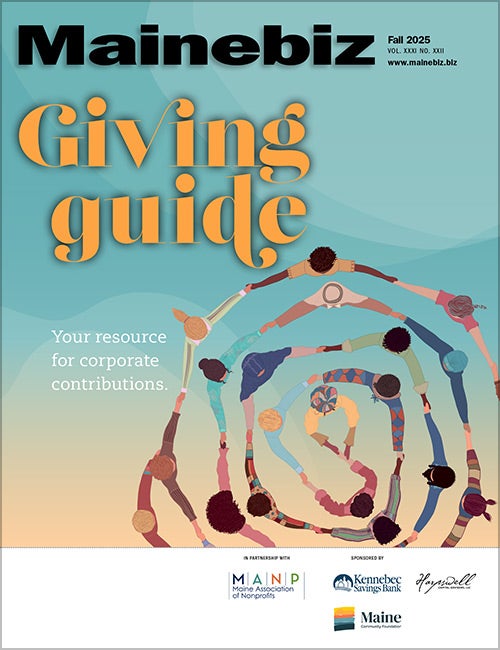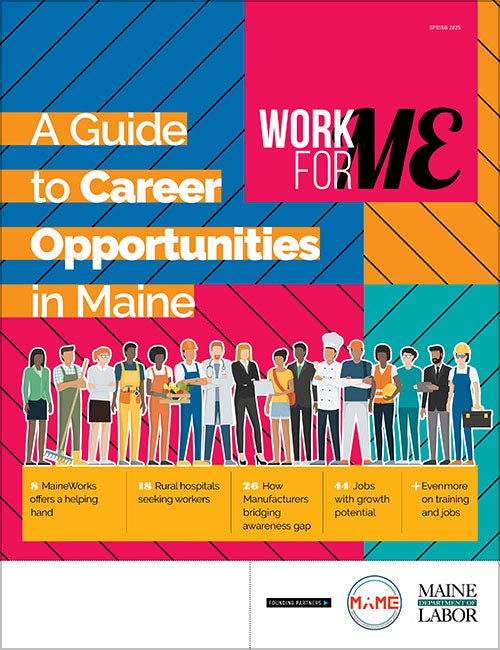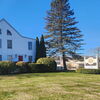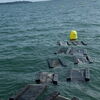Processing Your Payment
Please do not leave this page until complete. This can take a few moments.
- News
-
Editions
View Digital Editions
Biweekly Issues
- December 1, 2025
- Nov. 17, 2025
- November 03, 2025
- October 20, 2025
- October 6, 2025
- September 22, 2025
- + More
Special Editions
- Lists
- Viewpoints
-
Our Events
Event Info
Award Honorees
- Calendar
- Biz Marketplace
On the edge: Monhegan Island's year-round residents take charge of their future
 PHOTo / James McCarthy
Shermie Stanley, a fifth-generation lobsterman and Monhegan's harbor master, sitting on the second-floor deck of his fish house overlooking Monhegan Harbor. Stanley worked several years in the merchant trade, on Gulf Oil and Exxon ships, before returning to Monhegan.
PHOTo / James McCarthy
Shermie Stanley, a fifth-generation lobsterman and Monhegan's harbor master, sitting on the second-floor deck of his fish house overlooking Monhegan Harbor. Stanley worked several years in the merchant trade, on Gulf Oil and Exxon ships, before returning to Monhegan.
 PHOTo / James McCarthy
Ben Algeo, an Island Institute fellow, is working with Monhegan and Matinicus islands to identify their most pressing energy efficiency needs and possible solutions.
PHOTo / James McCarthy
Ben Algeo, an Island Institute fellow, is working with Monhegan and Matinicus islands to identify their most pressing energy efficiency needs and possible solutions.
Shermie Stanley doesn't need to read the Island Institute's 62-page 2011 status report on Maine's 15 year-round island communities to know how Monhegan Island is faring. All he has to do is look out from the deck of his fish house at the harbor that's been sheltering Stanley family boats since his great-great-grandfather began fishing Monhegan's waters in the 1800s.
Twenty years ago there were 17 boats in Monhegan's lobstering fleet; today there are eight, including his lobster boat named Legacy. “Lobstering used to be the big thing out here,” he says. “But things have changed so much. It's just crazy now. Everything is so expensive.”
A graduate of the Maine Maritime Academy, the 66-year-old Stanley initially made his living off the island, shipping for several years with Gulf Oil and Exxon and living on Monhegan only sporadically between jobs. But once he chose to settle on Monhegan, he's stayed — cobbling together a living as a lobsterman and proprietor of a summertime fish market and seafood restaurant, while also finding time to serve as harbor master.
But even a quick, 15-minute conversation with Stanley — who'd gone out at dawn the day before with the island's other lobstermen on Monhegan's iconic Trap Day, now held on Oct. 1 — gives credence to the Island Indicators 2010-2011 report's general finding that Maine islands “continue to have real challenges such as aging populations, declining school enrollment, limited employment opportunities and an elevated overall cost of living.” All true, but Stanley also points to the work being done by the Monhegan Island Sustainable Community Association to counter those trends, as well as creative solutions such as the Island Farm Project launched by islanders four years ago to provide more locally grown food for residents.
Monhegan's survival story, taking place 10 miles out to sea, is by no means over, but it already offers lessons and inspiration for mainland communities facing similar challenges.
Lots to farm
Walking the main island road recently, it's obvious the summer tourism season has run its course. No white sheets billowing like sails behind the Island Inn, only drooping hollyhocks and sunflowers dancing in a brisk wind. Pumpkins adorn steps of rental cottages that will soon be vacant, if they aren't already. The Monhegan House, just closed for the season. The Trailing Yew, soon to follow. By all appearances, Monhegan is getting ready to hunker down for the winter, when the island economy shifts from tourism to fishing and its roughly 45 year-round residents settle into slower but no-less-challenging lives.
It may be a perfect time for the island's first annual Fall Abundance Festival, whose organizer, Tara Hire, an Ohio native who's been living on Monhegan for 14 years, eagerly greets the two visitors who've shown up at the island's Pumpkin Garden for a 10 a.m. tour of the Island Farm Project. A graduate of the Island Institute's intensive one-year Island Sustainability through Leadership and Entrepreneurship program, Hire helped organize the three-day celebration that began with the Oct. 1 Trap Day, when year-round residents and a few remaining tourists showed up at dawn to see the island's eight lobstermen head out of the harbor with pot buoys and traps stacked high for the start of Monhegan's lobstering season. Early the next day she had led a yoga class at her Monhegan Wellness Studio.
Like all year-round island residents, Hire is a multi-tasker who runs the Wellness Studio while serving on various committees. A common theme of her year-long ISLE program, she says, centers on the question of how to develop stronger island economies and keep them local.
“What do we have here that we can create an industry around?” she says.
While the obvious answers for Monhegan had always been lobstering and its spectacular scenic beauty, historically low dock prices for lobsters in 2012 and 2013 and the lingering effects of the recession on tourism have spurred Hire and other islanders to take a broader look at that fundamental question. The Monhegan Island Farm Project — launched in 2010 by Kathie Ianniacelli, a gardener who for more than 20 years has maintained many of the island's flower gardens, and other islanders — is an early success.
“Monhegan used to be farmland. That's what people did in order to survive,” Hire says. “Then, in the 1960s or so, people stopped growing their own food. It was a reflection of what was happening elsewhere. Islands are simply a microcosm of the greater society.”
While the talk on the mainland increasingly is about Maine's potential of once again becoming the “breadbasket of New England” — as it was for much of the 1800s — Hire says the farm project's goal is simply for Monhegan to become its own breadbasket. A University of Maine study reported that residents of Maine's 15 year-round islands pay at least one-third more for basic food items than the state average.
Sue Jenkins, who works with Ianniacelli and Ronnie Short as the island farmers tending the project's 14 small plots scattered around the village, credits the Island Institute's Four Season Agriculture program, the Maine Organic Farmers and Gardeners Association, the Monhegan Island Church and a host of volunteers as early supporters who've helped the farm project.
“It's definitely a community-spirited project,” she says. “There's a huge amount of enthusiasm for it. It really has gone from a, 'Well, let's see how this works out,' to 'Yeah, I'd like to increase our share.' We had an awesome growing season this year.”
By early summer, Jenkins says, the farm project's gardens were providing vegetables for sale at the island's weekly farmers' market, as well as $10 and $20 shares for families who've signed up for a Community Supported Agriculture program. Instead of charging a lump sum as many CSAs do, she adds, the project bills its families every five or six weeks.
“We make deliveries to people's houses,” she says. “We'll even put it into the refrigerator for them … The goal of the farm is to produce a lot of food for the winter community.”
Filling a need
Lisa Brackett opened the island's sole grocery store, L. Brackett & Son, last Nov. 1, just one day after the Carina grocery store, which Hire had run for several years, was forced to close when the landlord decided to use the building for other purposes. Her motivation, she says, was first and foremost: To fill a need. “I'm serving the community and being there for the community,” she adds.
A grocery store provides a vital center for an island community, she explains, even though most families also have groceries delivered from the mainland. Some of the produce she sells comes from the island farm project's gardens, some comes in with other grocery staples that are delivered by the morning mail boat out of Port Clyde. Her suppliers have been Pine State Trading Co., New England's leading convenience store supplier, and Scotts Produce, a fruit and vegetable supplier based in Waldoboro.
“It definitely has been a lot of fun,” she says. “Everyone is very happy I opened the store. Everyone's been very helpful. It's been remarkable.”
While checking inventory in the back of her grocery in the afternoon of Oct. 2, Brackett acknowledges she was feeling the effects from Trap Day the day before. Like most islanders, she has several jobs besides owning a grocery store with her son, including being the sternman of Shermie Stanley's Legacy.
“We were the oldest crew and we're both feeling a bit crippled; Shermie and I both have bursitis,” she says with a chuckle.
Having a grocery store, and a school, are two essential elements of a viable year-round community, she says, noting that the Down East Magazine story published in May with the title “Last of the Monhegans” provided a fair assessment of the year-round islanders' sense of urgency due to the Carina store's impending closure last fall and having only one child attending school at the time the reporter was gathering information for the article.
“I felt the island was more energized this summer,” she says. “I don't think it's all dire. Last year I felt it was.”
Brackett says the Quadracentennial Celebration in August of Capt. John Smith's 1614 landing on Monhegan probably contributed to the sense of renewal, but she also feels the article gave islanders and longtime visitors alike a sense of urgency about some of the island's most-pressing problems. It's been a big relief, she adds, that several families have since moved onto the island with children who are now enrolled at the island school.
“I think we're all trying to do what we can to keep it a year-round island,” she says. “We need more opportunities for young people. We'd love to have more young families and their children. Everyone likes living here. It's emotional for me to think about leaving here.”
Craft beer with a breeze
Craft ale, locally brewed 10 miles out to sea? Monhegan's got it, making it the first outer island in Maine with its own microbrewery. Monhegan Brewing Co. was launched in 2013 by Matt and Mary Weber, with some expert assistance from Mary's father, Danny McGovern, who started Lake St. George Brewing Co. in the mid-1990s and has since worked at other breweries along the coast.
“It's a small operation in the big scheme of Maine breweries,” says Mary Weber, who taught for two years at the island's elementary school and whose husband, Matt, is both a full-time lobsterman and the co-president of the Monhegan Island Sustainable Community Association. “It's a business born from a hobby.”
Weber says she and her husband hatched the idea of making small-batch, hand-crafted beer on the island as a way to diversify the family's household income. “What kind of business could we open to take advantage of tourism?” she remembers her husband saying.
Her father serves as brew master, devising unique recipes that are brewed on-site and sold both on tap and in bottles. The beers come with names like Trap Stacker Special Ale, Black Head Russian Imperial Stout and Lobster Cove American Pale Ale that carry obvious references to the island's geography and culture.
“It's a challenge, because hauling all the stuff out here that we need to make the beer is a challenge,” Mary says. “But it's not something we didn't expect — because we live here.”
The seasonal business covers expenses and provides a modest supplement to her husband's lobstering income. Beyond that, it's proving to be exactly the kind of social meeting place she and her husband had envisioned, where tourists walking the path leading to Lobster Cove can stop for a beer and, more often than not, get the opportunity to meet and chat with islanders.
“It's a nice gathering spot,” she says. “We're getting a third fermenter so we can brew more frequently to keep up with demand. We're learning as we go along … We've gotten a lot of business guidance, most from the craft-brewing industry. Everybody has been forthcoming with information to help us.”
Bill Boynton, co-owner of the 30-year-old Lupine Gallery with his wife, Jackie Boegel, welcomes the Webers' micro-brewery as another example of how islanders are finding unique ways to meet the challenge of making a living on an outer island community.
“It makes a huge difference to two people,” he says of their venture. “And two people make a huge difference to the island.”
Finding a balance
Boynton says he and his wife moved out to the island in 1970 and have owned the Lupine Gallery for 30 years. Their gallery, located in a prime spot at the top of the hill leading up from the town dock, features paintings and prints by up to 40 contemporary artists who live or work on Monhegan, as well as paintings by a select group of 19th and 20th century Monhegan artists.
“I spent my summers here growing up,” he says. “My mother was an artist. That's why I'm here. She came out as an art student in the '30s. It grabs you. A lot of talented people have been coming here for a long time.”
As year-round residents whose livelihoods are tied to tourism, Boynton and Boegel say the island's overall economy has struggled since the recession. “Tourism, and specifically art, are definitely tied to having disposable income,” Boynton says. “It's been challenging for six years. As of this year, we've seen it bottom out and improve a little bit.”
Both agree the island's greatest challenge is keeping enough year-round residents, especially families with young children, to remain viable as a true working community and not just a summer destination for artists, vacationers and day-trippers.
“This community has really been proactive,” says Boegel, citing as prime examples Monhegan Island Sustainable Community Association initiatives to purchase the building being leased to Lisa Brackett for her grocery store, as well as its purchase of the former Monhegan Store to create space for two businesses, the post office, the Monhegan Plantation office and two affordable condominium apartments. MISCA also has helped several families purchase or lease year-round homes.
“We're on the edge of not being a viable year-round community,” says Boegel. “But we're all pretty confident we'll find ways to keep this place sustainable.”
Read more
Report: Maine's aging population hinders growth
Monhegan Brewing releasing new beer to support Maine's island communities
Island Institute takes close look at islands' energy costs
Ben Algeo knew he didn't want to be a “pencil-pusher” when he graduated in May from the University of Maine with a bachelor's degree in political science and renewable energy, and he also wanted to live and work in Maine.
He's accomplishing those goals as one of two Island Institute fellows with multiple island assignments. The other fellow is working on elder-care issues on Chebeague, North Haven, Vinalhaven and Swan's Island, while Algeo’s assignment is to work with residents of Monhegan and Matinicus on energy issues. Given that both are diesel-powered islands and have some of Maine’s highest electricity rates (Monhegan’s 70 cents per kilowatt hour being among the highest rates in the nation), his first project focuses on energy efficiency.
It includes doing room-by-room inventories of electric appliances and light fixtures in island homes to identify where efficiencies might be gained that would reduce usage and costs.
“Our goal is to take that data and use it to identify what the largest needs are,” Algeo says, adding that an obvious low-hanging fruit would be to replace incandescent light bulbs with long-lasting energy-efficient LED bulbs. As another example, he says, if the surveys on Monhegan and Matinicus identify a large number of energy hogs, like old refrigerators, that information could be used to leverage significant group discounts with appliance distributors on the mainland.
“We just want to make it as simple and as cost-effective as possible to help these islands reduce their energy costs,” he says.
Algeo says the time he's already spent on Monhegan — and he expects it will hold true when he begins working on Matinicus this month — has given him a deep appreciation of the year-round islanders' frugality when it comes to energy. “These people here can run circles around mainlanders in terms of energy conservation,” he says. “Everyone uses clotheslines. Everyone turns the heat down when they're not in the house. Everyone puts on extra layers of clothing to keep warm. Everyone washes dishes by hand. It's the way they do things out here.”
As an Island Institute fellow, Algeo says his role is to facilitate conversations about energy efficiency on Monhegan and Matinicus, as well as between the islands and other island communities facing similar problems. “It's important to respect their autonomy,” he adds. “They take pride in that autonomy. Monhegan is not Matinicus and Matinicus is not Monhegan. But certainly there are common problems that they can learn from each other about.”
— JAMES MCCARTHY
Mainebiz web partners

The Giving Guide
The Giving Guide helps nonprofits have the opportunity to showcase and differentiate their organizations so that businesses better understand how they can contribute to a nonprofit’s mission and work.
Learn More
Work for ME
Work for ME is a workforce development tool to help Maine’s employers target Maine’s emerging workforce. Work for ME highlights each industry, its impact on Maine’s economy, the jobs available to entry-level workers, the training and education needed to get a career started.
Learn More
Groundbreaking Maine
Whether you’re a developer, financer, architect, or industry enthusiast, Groundbreaking Maine is crafted to be your go-to source for valuable insights in Maine’s real estate and construction community.
Learn more-
The Giving Guide
The Giving Guide helps nonprofits have the opportunity to showcase and differentiate their organizations so that businesses better understand how they can contribute to a nonprofit’s mission and work.
-
Work for ME
Work for ME is a workforce development tool to help Maine’s employers target Maine’s emerging workforce. Work for ME highlights each industry, its impact on Maine’s economy, the jobs available to entry-level workers, the training and education needed to get a career started.
-
Groundbreaking Maine
Whether you’re a developer, financer, architect, or industry enthusiast, Groundbreaking Maine is crafted to be your go-to source for valuable insights in Maine’s real estate and construction community.
ABOUT
NEW ENGLAND BUSINESS MEDIA SITES
No articles left
Get access now
In order to use this feature, we need some information from you. You can also login or register for a free account.
By clicking submit you are agreeing to our cookie usage and Privacy Policy
Already have an account? Login
Already have an account? Login
Want to create an account? Register
Get access now
In order to use this feature, we need some information from you. You can also login or register for a free account.
By clicking submit you are agreeing to our cookie usage and Privacy Policy
Already have an account? Login
Already have an account? Login
Want to create an account? Register






Comments